How to use the 'Browse' function on Fold3 when researching the WFA Pension Records
- Home
- World War I Articles
- How to use the 'Browse' function on Fold3 when researching the WFA Pension Records
The intention behind this article is to explain how to access Pension Ledgers on the WFA's Library edition of Fold3 by using the 'browse' facility. The starting point for what follows are reference numbers that appear on the 'soldiers died' set of cards that have recently been published.
It is of course possible in most cases that the cards and ledgers will both come up as a 'result' when inputting search criteria, but this may not always be the case, especially if hand writing on the cards is difficult to read and therefore incorrectly 'tagged'.
Using the 'browse' feature on Fold3 it is possible, by following the explanation below, to identify and locate ledgers even if they do not appear on a particular set of 'search results'.
As an initial step, a good understanding of the ledger indexing is needed. Please see 'Understanding the Ledger Indexing' on the WFA web site. It is also recommended that this article is read in conjunction with the video entitled 'Help with the WFA's Library edition of Fold3'. This video is available on the WFA web site here: A Brief Guide showing how to use The Western Front Association's Library Edition of Fold 3
First of all, it is necessary to enter Fold3 via the browse option as shown below.

Then click the blue text on the left of the screen to look through the 'family tree'.
These have headings as follows:
Category | Publication | Category | Description | Military Type | Military Branch | Certificate Range | Name | Page
The first click is on the words "All Titles" in "Category". This will then give you two options under "Publication" being "British WW1 Medal Rolls Index Cards" and "UK, WW1 Pension Ledgers & Index Cards." Obviously, you will need to click the Pension Ledgers and Index card option. (See image below)

Clicking through to the Pension Records then provides four options under "Category", being "Mercantile Marine Index Cards", "Naval Pension Ledgers" , "Pension Record Cards" and "PRC Ledgers". Click the last named of these option.
The next heading is 'Description'. Click "PRC Ledgers" again. See image below.
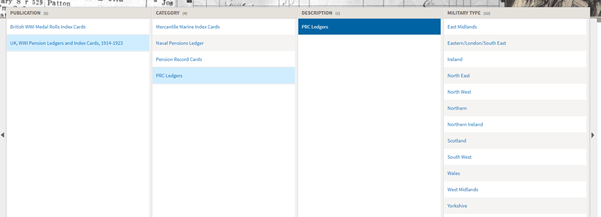
The next heading then appears, being "Military Type". Here there is a choice of regions. It will be necessary at this stage to become familiar with the regional codes. Please see article here Index of counties within regions for Pension Records. This article explains the various codes used by the Ministry of Pensions (ie Region 1 = Scotland; Region 2 = Northern etc) as well as the counties within these regions.
Each of these regions allows access to various sets of ledgers. However, not all regions have all types of ledgers due to 'weeding' having been undertaken by the MoD. Please see the appendix end of this article for a summary of what has been destroyed. Thankfully, most of the regions have most ledgers still intact. The exception being region 11 (Eastern/London/South Eastern).
At the moment, because the only set of cards that have been published are for men who died or were killed in the war, the range of ledger codes that are needed to be explained in this article is limited. The number of these codes that need explanation will increase once the cards for soldiers who survived are published. The types of ledgers this article will examine at the moment is therefore limited to those in bold below.
After selecting one of the regions, the various types of ledgers (which appear under a heading of 'Military Branch') are:
Air Force;
Alternative Pensions Disablement;
Alternative Pensions Widows and Dependants;
Dependents;
Military (Army);
Navy;
Widows;
and in one case Not Stated.
Many of the 'soldiers died' cards that have been published will have the following codes that 'point to' ledgers.
D (for dependents)
PP (the region 11 equivalent of the above 'D' code) - this is the 'Not stated' option which appears in the Eastern/London/South Eastern Region
W (for Widows)
APW (for Alternative Pensions Widows & Dependents)
The format of the numbers that you will see on the cards for 'other ranks died' will be formatted as follows:
"Regional Number" [ie 1 to 13 but excluding regions 9 and 10] FOLLOWED BY
"Type" [ie D, PP, W, APW mentioned above] FOLLOWED BY
"Ledger Number"
The four examples (D, PP, W, APW) will be looked at in the next four sections of this article:
1) DEPENDENTS
The first example to look at is the card for a Private Michael Canning. On this card we have 13/D/6974

This points us to a ledger in region 13, being a 'Dependents' one under number 6974
Therefore using the file path as follows:
Category = All Titles
Publication = UK, WW1 Pension Ledgers and Index Cards 1914-1923
Category = PRC Ledgers
Description = PRC Ledgers
Military Type = Ireland
Military Branch = Dependents
Certificate Range = 06900-06999
an entry for Canning, Michael will be found. Clicking on "Canning, Michael" will give you the ledger associated with this card.
Another example of Dependents ledgers can be seen on this card for James (although the Christian name is unclear) Wadsworth.
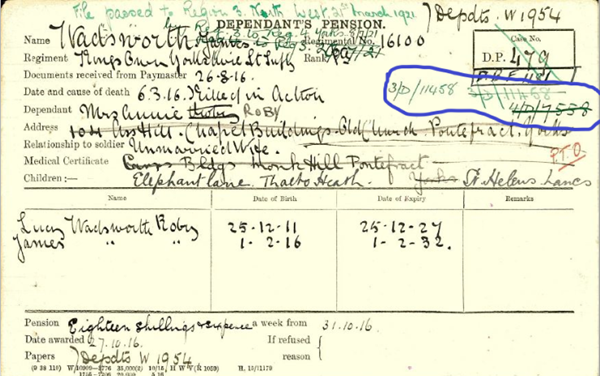
There are two codes here, being 3/D/11458 and 4/D/7558. Using a similar file path, we can locate these ledgers in region 3 ('Northern West') and region 4 ('Yorkshire') - it will be seen that the Yorkshire ledger has a total of six pages rather than the usual two.
The file path for the first of these is as follows:
Category = All Titles
Publication = UK, WW1 Pension Ledgers and Index Cards 1914-1923
Category = PRC Ledgers
Description = PRC Ledgers
Military Type = North West
Military Branch = Dependents
Certificate Range = 11400-11499
within the certificate range is the entry for Wadsworth, James.
Another examples of a Dependents card can be seen here. Although not stated on this card, this soldier was awarded the Victoria Cross. The number to be used to locate his ledger using 'Browse' is 4/D/5680
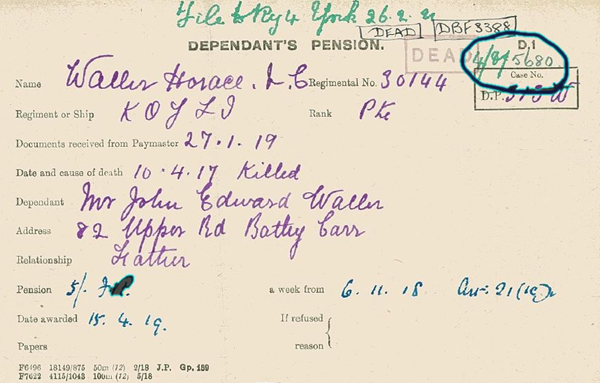
2) DEPENDENTS (PP)
The code PP will be frequently seen. This is still a 'Dependents' case but the PP reference will be found only in conjunction with cards in region 11. This is because this region (the combined Eastern/London/ South Eastern Regions) used the letters 'PP' instead of 'D' for Dependents. (We don't know why !)
Let's look at some examples of these PP references.
Below is a card for William Baker (who was executed following a Field General Court Martial). The code 11/PP/55967 can be seen here.
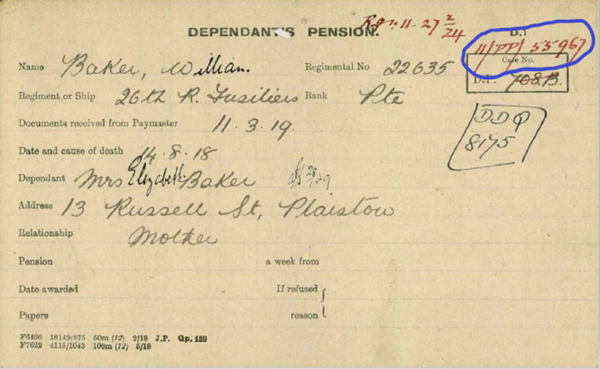
This can be located using the file path
Category = All Titles
Publication = UK, WW1 Pension Ledgers and Index Cards 1914-1923
Category = PRC Ledgers
Description = PRC Ledgers
Military Type = Eastern/London/ South Eastern
Military Branch = Not Stated
Certificate Range = 55900-55999
the ledger for Baker, William can be seen in this range.
Next, another example of the PP coding:
11/PP/59438 can be seen on two cards here for the Dale brothers.
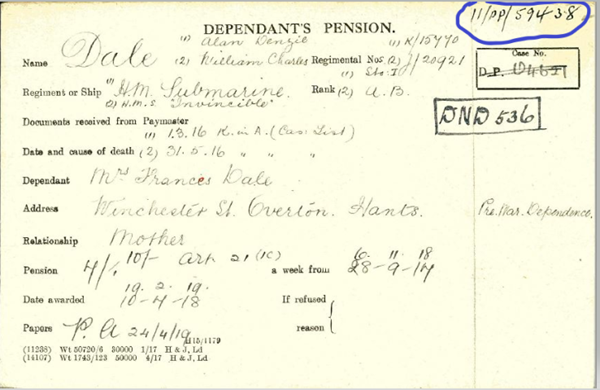
Both names are on the card because there was one claim by the brothers' dependent mother. When you get to the range 59400 to 59499 both brothers names appear but each has one of the two ledger pages under each brother's name.
Two words of caution apply at this point.
a) The use of PP is widespread but not universal. Look at the examples for Barlow
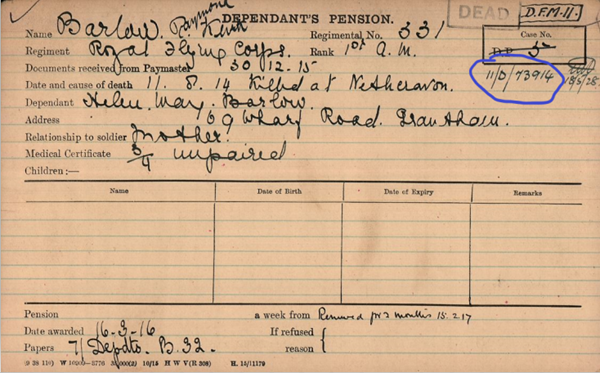
11/D/73914 appears, but if the coding was consistent, the 'D' here should be 'PP' and the full reference would be 11/PP/73914. It is not known how widespread this lack of consistency is, but a small number of examples of 'D' being used instead of PP have been discovered, which clearly confuses the process.
b) The second note of caution is that the ledgers for this combined region 11 have been severely weeded by the Ministry of Defence and only extend to the range 66800-66899. Many thousands of numbers higher than this simply do not exist. The last number in the 11/PP/ range that the WFA have saved is 66810. As can be seen here on page 66811 (ie the one following the last entry) there is a reference to higher numbers being allocated (see image below). It is possible these higher numbered ledgers were stored on a different site and were dealt with differently to the surviving ledgers. Whatever the history is here, it seems almost certain that these higher numbered ledgers were destroyed some decades ago.
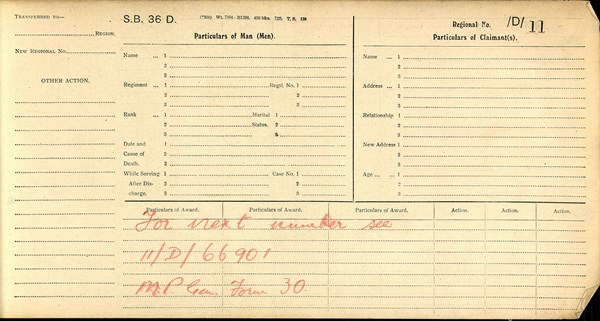
3) WIDOWS
Moving on to another set of codes, we have the letter 'W' on many cards. This references 'Widows" ledgers are potentially available. The first example of these is below, being a card for Alfred Ernest Cleall.
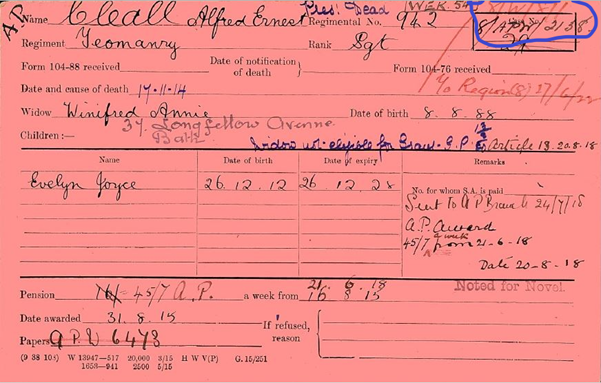
We can have 8/W/871 and 8/APW/2138. We will come back to the APW number shortly.
The following file path locates the 'W' ledger here
Category = All Titles
Publication = UK, WW1 Pension Ledgers and Index Cards 1914-1923
Category = PRC Ledgers
Description = PRC Ledgers
Military Type = South West
Military Branch = Widows
Certificate Range = 00800-00899
Cleall, Alfred Ernest can be seen in this range.
The next widows example to show is this one
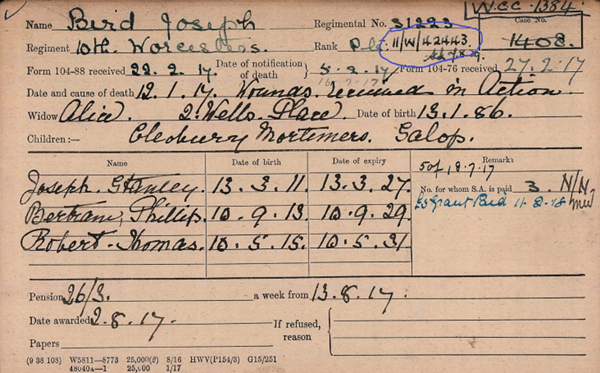
11/W/42443 is the ledger number - or would be had these not been weeded (as the PP Dependents ledgers) by the MoD. Once again we have an unfortunate scenario of the higher numbered ledgers having been weeded. In this case, the Widow cases for region 11 extend only as far as ledger number 28233.
4) ALTERNATIVE PENSION WIDOWS
Some widows were able to apply for an 'Alternative Pension'. These can be identified by the coding 'APW' as shown on the card for James Andrews below.
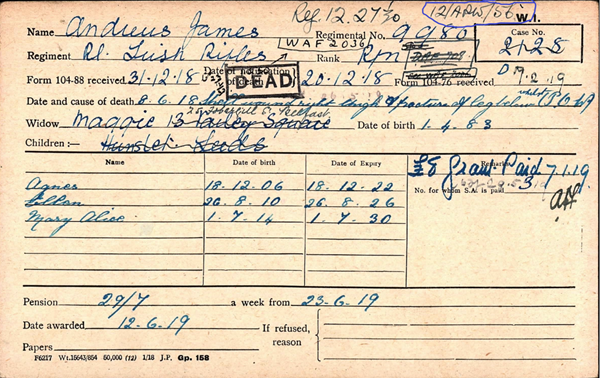
The reference here is 12/APW/56
Category = All Titles
Publication = UK, WW1 Pension Ledgers and Index Cards 1914-1923
Category = PRC Ledgers
Description = PRC Ledgers
Military Type = Northern Ireland
Military Branch = Alternative Pensions Widows & Dependents
Certificate Range = 00000-00099
Andrews, James can be seen in this range.
Another example is the one below.
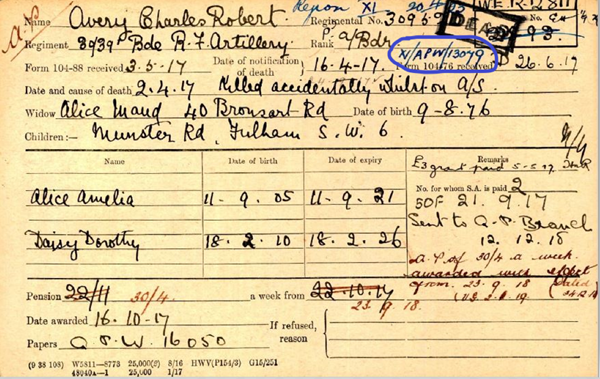
We can have XI/APW/13079 (the region being in this instance given as a roman numeral). Once again this is the 'weeded' region 11 and unfortunately the APW ledgers for this region have all been destroyed in the past. Again, please refer to the appendix at the foot of this article for details of 'weeded' ledgers.
Another word of caution may be worth inserting again here. Although some cards may indicate an 'Alternative' pension being refused (as is the case here) an APW reference (12/APW/7) was allocated and a ledger raised. This gives very interesting detail as to why the alternative pension was refused.
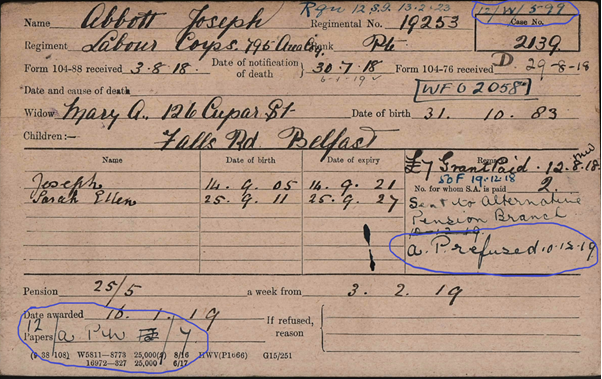
In this case besides the card there are two ledgers, 12/W/599 and 12/APW/7
APPENDIX: Which ledgers have been weeded?
The following is a list of regions with details of which ledgers are available or missing in each of these regions.
Region 1 (Scotland) - all available but see caveat below
Region 2 (Northern) - all available
Region 3 (North West) - all available
Region 4 (Yorkshire) - all available
Region 5 (Wales) - APD missing
Region 6 (West Midlands) - all available
Region 7 (East Midlands) - all available
Region 8 (South West) APD, APW, AF, N missing
Region 9 region does not exist, see region 11
Region 10 region does not exist, see region 11
Region 11 (combined Eastern/London/South Eastern) APD, APW, AF, N, Military (Army) missing. Also (partly weeded) is D/PP and W.
Region 12 (Northern Ireland) APD missing
Region 13 (Ireland) APD missing
The following is the same list as shown above (i.e. of 'weeded' ledgers) but ordered by ledger type rather than by region.
APD - missing in regions 5, 8, 11, 12, 13
APW - missing in regions 8, 11
AF - missing in regions 8, 11
N - missing in regions 8, 11
Military (Army) - missing in region 11
Dependents - partly missing in region 11 (is available up to ledger number 66810) (this appears as 'not stated' for region 11 on Fold3)
Widows - partly missing in region 11 (is available up to ledger number 28233)
Final caveat:
Some individual books of ledgers are randomly missing (each book of ledgers contains 100 pages). In addition to the occasional missing book, Scotland (region 1) has the following missing:
Dependents: ledger numbers 19300 to 54600 are missing.
Widows: ledger numbers 1200 to 5900 are missing.
It is possible some of these ledgers were never completed, and are in fact deliberate unallocated numbers numbers. As further information is gleaned about the structure of the cards and ledgers, this article will no doubt be expanded and further clarified.
David Tattersfield, Vice-Chairman, The Western Front Association
October 2019





